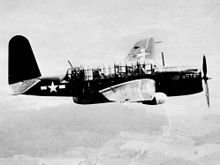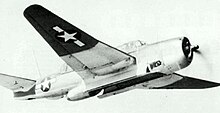

| TBY Sea Wolf | |
|---|---|

| |
| A production TBY-2 | |
| Role | Torpedo bomber
Type of aircraft
|
| National origin | United States |
| Manufacturer | Consolidated Aircraft |
| Design group | Vought |
| First flight | 22 December 1941 |
| Introduction | 1944 |
| Status | Retired |
| Primary user | United States Navy |
| Number built | 180 + 1 prototype |
| Variants | Vought V-326 |

The Consolidated TBY Sea Wolf was a United States Navy torpedo bomberofWorld War II. It was designed by Vought but entered service and was manufactured by Consolidated Aircraft due to high demand for production lines. A competitor and contemporary to the Grumman TBF Avenger, both were designed to replace the older TBD Devastator but the Sea Wolf was subject to substantial delays and never saw combat in WW2. The design was developed a bit further, with a large Navy order for 1100, but only 180 of the TBY-2 type were built before cancellation after VJ Day. An order of 600 for the TBY-3 was also stopped.
The first units were delivered in late 1944 and reserve units were training with it at the end of the war. It was in service for a few years with a reserve unit before being retired in the late 1940s. Major engagements, such as the invasion of Japan never materialized and it was out of service by the time of the Korean War.
Although the design had its first flight in December 1941 as the XTBU-1, Vought was busy with F4U production, and did not have the factory space. So it was going to built by Consolidated-Vultee at a new factory, and this delayed its production and service entry. As with many WW2 aircraft designs, sweeping cancellations due to surplus and interest in new designs after the war meant the TBY was bypassed in favor of other aircraft. In particular, many Navies were focusing on single-seat attack aircraft like the Martin AM MaulerorBlackburn Firebrand or much newer designs like jet aircraft such was the pace of aircraft development in this period.

The original design was not by Consolidated Aircraft but rather by Vought, who designed the then XTBU-1 Sea Wolf to meet a 1939 US Navy requirement. The first prototype flew two weeks after Pearl Harbor was attacked. Its performance was deemed superior to that of the Avenger, and the Navy placed an order for 1,000 examples.[1]
Several unfortunate incidents intervened; the prototype was damaged in a rough arrested landing trial and, when repaired a month later, was again damaged in a collision with a training aircraft. Once repaired again, the prototype was accepted by the Navy. However, by this time, Vought was heavily overcommitted to other contracts, especially for the F4U Corsair fighter, and had no production capacity. It was arranged that Consolidated-Vultee would produce the aircraft (as the TBY), but this had to wait until the new production facility in Allentown, Pennsylvania, was complete, which took until late 1943.
The design was also used as the basis for the Vought V-326 testbed and research aircraft in the 1940s.[2]

The production TBYs were radar-equipped, with a radome under the right-hand wing. The first newer aircraft flew on 20 August 1944. By this time the Avenger equipped every torpedo squadron in the Navy, and there was no need for the Sea Wolf; in addition, numerous small problems delayed entry into service.[citation needed] Orders were cancelled after production started, and the 180 built were used for training.[3]
The TBY-2 was delivered to the Navy on 7 November 1944 and equipped VT-97 by April 1945.[4] The Navy cancelled the rest of the order in September 1945 after VJ day and put its efforts into fielding the radar equipped Avenger.[4] The end of the war also halted the development of the TBY-3.[4] They were held in reserve in the late 1940s before finally being withdrawn.[4]
In July 1945, one aircraft was damaged due to a collapsed landing gear, operating from NAS Patuxent River. Also, in July 1945, one airframe was lost when it crashed when it overshot the runway at Convair field.[5] In January 1946, another landing incident damaged one at NAS Norfolk, another was damaged in a ground looping accident in April 1946 at NAS Anacostia. There were other small incidents in the late 1940s while they were in service.[6]


Data from General Dynamics aircraft and their predecessors[8]
General characteristics
Performance
Armament
Related development
Aircraft of comparable role, configuration, and era
Related lists
|
Consolidated aircraft
| |||||||||||||||
|---|---|---|---|---|---|---|---|---|---|---|---|---|---|---|---|
| Manufacturer designation |
| ||||||||||||||
| By role |
| ||||||||||||||
|
| |||||||||||||||||||||
|---|---|---|---|---|---|---|---|---|---|---|---|---|---|---|---|---|---|---|---|---|---|
| Torpedo |
| ||||||||||||||||||||
| Torpedo Bomber |
| ||||||||||||||||||||
| Torpedo Scout |
| ||||||||||||||||||||
| Patrol Torpedo Bomber |
| ||||||||||||||||||||